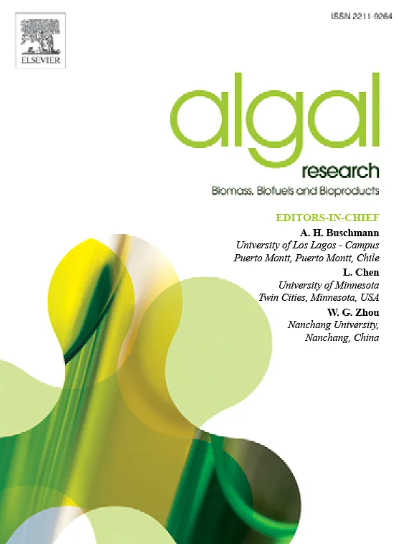马尾藻床对邻近沉积物岩心固碳和微生物群落结构的影响
IF 4.6
2区 生物学
Q1 BIOTECHNOLOGY & APPLIED MICROBIOLOGY
Algal Research-Biomass Biofuels and Bioproducts
Pub Date : 2025-04-17
DOI:10.1016/j.algal.2025.104045
引用次数: 0
摘要
输送到深海的海藻碎屑是海洋固碳的重要组成部分。然而,海藻分解对邻近沉积物的影响以及微生物群落的响应机制尚不清楚。本研究分析了涠洲岛近海马尾藻不同距离(1、2、3 km)沉积物岩心中碳、氮含量、溶解有机质(DOM)分子组成和微生物群落的变化。结果表明,马尾藻对沉积物岩心的影响具有较强的空间异质性,在离岩心最近的位置发现了更多的类芳香分子和单宁分子(S1)。与其他两个沉积物岩心相比,S1沉积物的微生物群落组成存在显著差异。S1处的微生物群落组装以均匀选择为主。此外,马尾藻分解有机质的输入导致S1阶段碳氮分解相关功能基因丰度显著增加,导致沉积物中TOC和TN含量显著降低。研究表明,马尾藻的分解增加了邻近沉积物中有机质的来源和分子种类,促进了有机质的微生物分解。加强马尾藻床的保护有助于改善生物多样性,促进海洋碳氮循环。本文章由计算机程序翻译,如有差异,请以英文原文为准。
Effects of Sargassum beds on carbon sequestration and microbial community structure in the adjacent sediment cores
Seaweed detritus transported to the deep sea is an important component of marine carbon sequestration. However, the impacts of seaweed decomposition on adjacent sediments and the response mechanisms of microbial communities are still unclear. In this study, we analyzed the changes in carbon and nitrogen contents, the molecular composition of dissolved organic matter (DOM), and microbial communities in three sediment cores at different distances (1, 2, and 3 km, respectively) from Sargassum beds in Weizhou Island coastal waters, China. The results show that the impact of Sargassum on sediment cores exhibits strong spatial heterogeneity, with more aromatic-like and tannin molecules found at the nearest site (S1). Compared to the other two sediment cores, the microbial community composition of S1 is significantly different. The homogeneous selection dominates the assembly of the microbial community at S1. In addition, the input of decomposing organic matter from Sargassum contributed to a significant increase in the abundance of functional genes related to carbon and nitrogen decomposition at S1, leading to a significant decrease in TOC and TN content in the sediments. Our study demonstrated that the decomposition of Sargassum increased the sources and molecular species of organic matter in the adjacent sediments and stimulated microbial decomposition of organic matter. Strengthening the protection of Sargassum beds contributes to improving biodiversity and promoting the marine carbon and nitrogen cycles.
求助全文
通过发布文献求助,成功后即可免费获取论文全文。
去求助
来源期刊

Algal Research-Biomass Biofuels and Bioproducts
BIOTECHNOLOGY & APPLIED MICROBIOLOGY-
CiteScore
9.40
自引率
7.80%
发文量
332
期刊介绍:
Algal Research is an international phycology journal covering all areas of emerging technologies in algae biology, biomass production, cultivation, harvesting, extraction, bioproducts, biorefinery, engineering, and econometrics. Algae is defined to include cyanobacteria, microalgae, and protists and symbionts of interest in biotechnology. The journal publishes original research and reviews for the following scope: algal biology, including but not exclusive to: phylogeny, biodiversity, molecular traits, metabolic regulation, and genetic engineering, algal cultivation, e.g. phototrophic systems, heterotrophic systems, and mixotrophic systems, algal harvesting and extraction systems, biotechnology to convert algal biomass and components into biofuels and bioproducts, e.g., nutraceuticals, pharmaceuticals, animal feed, plastics, etc. algal products and their economic assessment
 求助内容:
求助内容: 应助结果提醒方式:
应助结果提醒方式:


